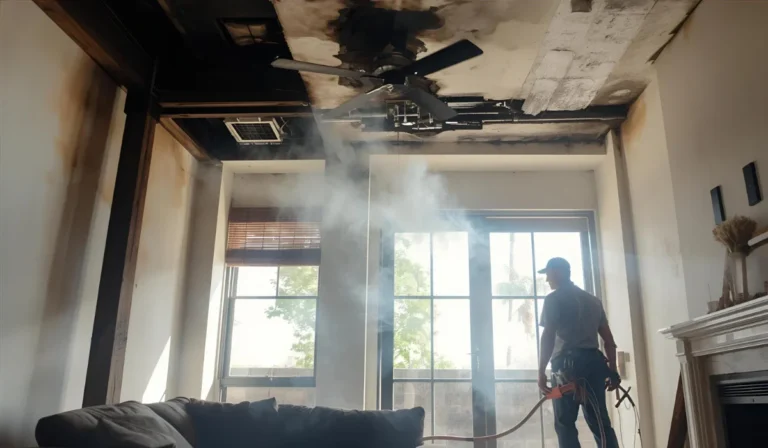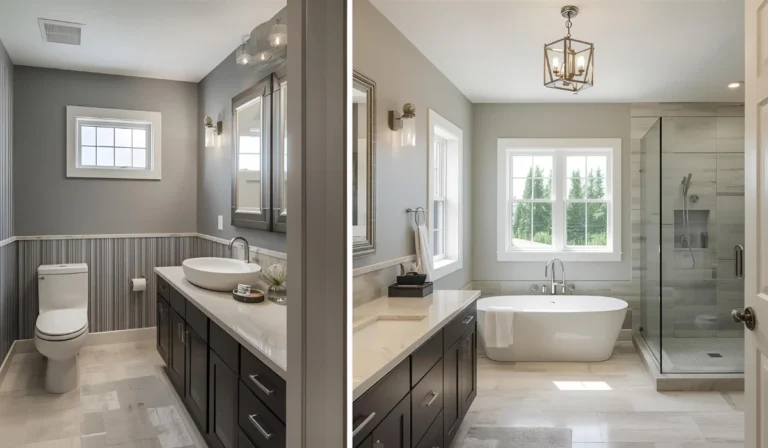For homeowners planning a renovation, understanding the difference in cost between remodeling a single half-bath and a full master bath in 2025 is essential. The gap in investment is significant.
A half-bath remodel typically costs between $3,000 and $10,000, while a complete master bath overhaul costs significantly more, ranging from $15,000 to over $40,000+. This substantial difference in price is fundamentally driven by size and plumbing complexity. A half-bath only requires cosmetic updates to a toilet and sink, whereas a master bath demands extensive custom tiling, the addition or replacement of a complex shower or bathtub system, and often premium, high-end materials.
The most critical distinction is complexity: a half-bath refresh is a high-ROI, budget-friendly project, whereas a master bath redesign is a large-scale, complex investment focused on luxury and personalized function. This comprehensive guide breaks down the precise cost factors, size considerations, and crucial Return on Investment (ROI) for both project types to help you build an accurate, competitive budget.
Key Takeaways
|
Cost Comparison at a Glance: Half-Bath vs. Master Bath (2025)
The table below provides a quick budget comparison and expected ROI based on the scope of work:
| Bathroom Type | Size (Sq. Ft.) | Typical Cost Range (2025) | Estimated ROI | Primary Cost Drivers |
| Half-Bath (Powder Room) | 20-40 sq. ft. | $3,000 – $10,000 | 70%-80% | Vanity/Sink, Labor, and Fixture Upgrades (no wet areas). |
| Guest/Full Bath | 40-75 sq. ft. | $8,000 – $20,000 | 65%-75% | Addition of a shower/tub, more tile, and increased labor hours. |
| Master/Primary Bath | 80+ sq. ft. | $15,000 – $40,000+ | 50%-65% | Larger area, custom cabinetry, separate tub/shower, and premium materials/appliances. |
Deep Dive: Half-Bath vs. Master Bath Cost Breakdown
Understanding the range is key, but the context of the work drives the final price. Here is a closer look at what drives the price of each project type.
Half-Bath Remodel: Cost and Focus
A half-bath (or powder room) is the most straightforward and affordable bathroom to renovate. Since there is no shower or tub, you eliminate the major costs associated with extensive waterproofing, tiling of wet walls, and high-cost shower/tub fixtures.
- Low-End Refresh ($3,000-$5,000): Focuses on surface-level cosmetic changes. This includes fresh paint, replacing the vanity/pedestal sink with a stock model, swapping the toilet, and updating the light fixture/mirror.
- Mid-Range Update ($5,000-$10,000): Includes replacing the toilet and sink, adding new ceramic or porcelain tile flooring, and potentially upgrading to a more unique or semi-custom vanity. Crucially, plumbing is typically left in place to maintain budget efficiency.
Master Bath Remodel: Cost and Complexity
The master bathroom, or primary suite, is where homeowners typically invest the most, driven by its size, daily use, and desire for a spa-like feel. The higher costs are due to multiple fixtures, more materials, and complex installations, such as separated bathing areas.
- Mid-Range Remodel ($15,000-$25,000): Includes a full tear-out, installation of a double vanity, a new tiled shower/tub combo, mid-grade porcelain tile flooring, and quality fixtures. The layout generally remains the same to save on expensive plumbing re-routing.
- High-End Renovation ($25,000-$40,000+): This often involves a complete gut and redesign to create a custom space. Costs cover premium features like:
- Separate walk-in shower with a frameless glass door.
- Freestanding soaking tub.
- Custom-built cabinetry or furniture-style double vanity.
- High-end materials (quartz, natural stone, elaborate tile work).
- Relocation of plumbing or walls (the single biggest budget factor).
Cost Factors by Bathroom Size (Square Footage Breakdown)
Home remodel costs are often calculated by square foot. For budgeting purposes, here are the estimated ranges for common bathroom dimensions in 2025:
| Bathroom Size | Typical Function | Estimated Remodel Range (2025) | Key Cost Impact |
| 5 x 7 (35 sq. ft.) | Small Full/Guest Bath | $8,000 – $14,000 | Smallest size for a full bath; less material needed, but labor can be tight. |
| 5 x 10 (50 sq. ft.) | Standard Full Bath | $10,000 – $18,000 | Large enough for a separate tub and shower, or a double vanity (increasing fixture costs). |
| 8 x 10 (80 sq. ft.) | Large Full/Small Master Bath | $15,000 – $25,000 | Easily accommodates a double vanity and a separate shower, driving up material and labor costs. |
| 10 x 10 (100 sq. ft. +) | Primary/Luxury Master Suite | $20,000 – $40,000+ | Large canvas for custom design, luxury features like heated floors, and extensive storage. |
6 Critical Factors Driving Your Total Remodel Cost
To plan accurately, you must allocate your budget across these core components. As noted, labor and materials typically make up 75% to 85% of your total budget.
1. Labor Costs: The Largest Variable (50%-60% of Budget)
Labor is the single largest component. If you move plumbing, electrical, or walls, costs escalate significantly.
- Plumbers: $75-$150 per hour
- Electricians: $50-$130 per hour
- Tile Installers: $10-$20 per square foot (labor only)
2. Plumbing and Layout Changes
This is the most costly structural change. Moving a toilet or shower drain can easily add $2,000 to $5,000 per fixture moved because it requires breaking into the sub-floor and re-routing main lines.
3. Fixture and Vanity Quality
Quality dictates price. For a master bath, most homeowners upgrade to better materials.
- Vanity/Cabinets: Stock models range from $500 to $1,500; custom, furniture-grade cabinetry can run from $3,000 to over $10,000.
- Showers/Tubs: A prefab insert is cost-effective, but a custom tiled walk-in shower with a frameless glass door can cost $3,500 to $8,500 or more.
4. Tiling and Flooring
The cost here is two-fold: material price and labor intensity.
- Material: Ceramic or porcelain is budget-friendly, while natural stone (marble, granite) is expensive, starting at $15-$25 per square foot.
- Installation: Intricate patterns (like herringbone) or small mosaic tiles are more labor-intensive and expensive to install than large-format tiles, increasing labor hours.
5. Permits and Professional Services
Major renovations involving structural, electrical, or plumbing work require permits to ensure compliance with local codes. Costs range from $100 to $1,500, depending on your municipality and project scope.
6. Contingency Budget (The Safety Net)
Always allocate a 10% to 20% contingency fund. This is essential for dealing with unforeseen issues common in remodels, such as finding water damage, mold, or outdated wiring/sub-flooring behind existing walls.
The ROI Factor: Where Does Your Money Go Furthest?
| Project Type | Why the ROI is High/Low |
| Half-Bath (Powder Room) | High ROI (70%-80%): Low initial cost combined with high buyer appeal. Adding a half-bath where one didn’t exist can significantly increase home value, as it adds functionality with minimal cost outlay. |
| Master/Full Bath | Moderate ROI (50%-65%): Although the percentage is lower, the absolute value added is often higher. Buyers highly value a modern, functional, and luxurious master suite, making it a critical investment for homes above a certain price point. |
Conclusion
Remodeling your bathroom is one of the most impactful home investments you can make, but understanding the significant cost difference between a half-bath and a master bath is crucial for budget success.
While a half-bath remodel offers the highest percentage ROI due to its low initial cost and minimal scope, a master bath remodel drives the highest absolute dollar value in high-end homes, despite its complexity and higher price tag ($15,000 to $40,000+). Your final cost will ultimately depend on material choices, the scope of plumbing changes, and local labor rates. Focus your budget on the biggest value-adds: professional labor and durable, modern fixtures.
Bathroom Renovation FAQs
Is It Okay To Only Have A Half-Bath In The Master Bedroom?
No. A master suite with only a half-bath is generally considered a dealbreaker for most buyers. A full, private master bathroom (with a shower or tub) is a critical and highly-expected feature for a home to sell at its full potential value.
What Is The Difference Between A Full Bath, A Three-Quarter Bath, And A Half-Bath?
A Full Bath has four fixtures: a toilet, sink, bathtub, and shower. A Three-Quarter Bath has three fixtures (usually a toilet, sink, and shower). A Half-Bath has two fixtures: a toilet and a sink, and is typically located on the main level for guests.
Does A Three-Quarter Bath Count As A Full Bathroom When Selling A House?
No, it does not. A three-quarter bath lacks a bathtub, which is required for a bathroom to be classified as “full” in real estate listings and appraisals.
Which Renovation Gives A Better Return: A New Half-Bath Or An Updated Master Bath?
Adding a new half-bath to a home with only one full bath often provides a higher return on investment (ROI) because it dramatically increases the home’s total functionality. However, upgrading an outdated master bath is also a high-ROI project, especially if the master suite lacks a full bath.
How Much Value Does Adding A New Half-Bath Add To A Home?
Adding a new half-bath is one of the most profitable home improvements, offering a high return, often recouping most of the cost. Its value is highest in homes that currently only have one full bathroom.
What Are The Best Ways To Make My Small Half-Bath Look Bigger?
The best ways are to install a large, wall-to-wall mirror (to reflect light and double the perceived space), use a wall-mounted or floating vanity (to expose more floor), and keep the color scheme light or monochromatic for visual continuity.
Should I DIY My Half-Bath Remodel, Or Will That Lower My Home’s Value?
A DIY remodel risks lowering the value if the workmanship is not professional, especially with complex tasks like plumbing and tiling. While DIY saves on labor, a poor-quality job or one that violates code can deter buyers and reduce the final sale price. For high ROI, professional-quality work is crucial.







